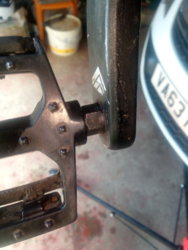D
Deleted member 89023
Guest
Hi all, any ideas on how to remove a seized pedal? I've twisted allen keys, rounded spanners and taken the skin off my hands trying. It's a hexagonal shape and I think it may be Halfords' own brand.
I know there's a lesson here (always grease the threads) but all I need to know is if it's possible to shift because if not I'm probably looking at a new crank set. For what it's worth, here's a photo. Thanks.
I know there's a lesson here (always grease the threads) but all I need to know is if it's possible to shift because if not I'm probably looking at a new crank set. For what it's worth, here's a photo. Thanks.


